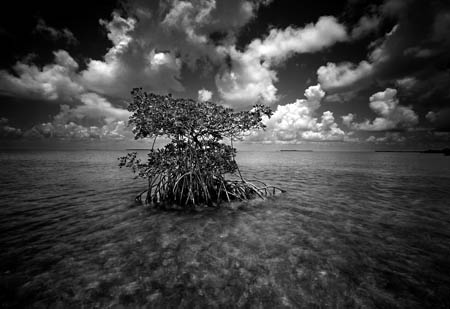Fragile Environments at the Wildling
Fragile Environments: Photographs of Antarctica and the Everglades by Roger Craton and Clyde Butcher.

The current photography exhibit on view at the Wildling Museum of Art in Los Olivos juxtaposes the beauty of two drastically different landscapes.Fragile Environments: Photographs of Antarctica and the Everglades by Roger Craton and Clyde Butcher contrasts the frozen landscapes of the South Pole with the damp, overgrown tropics of Florida’s famous wetlands.
These two very different photographers share the same purpose, which is helping to document the serious environmental threats facing ecological sanctuaries. During the past 200 years, the United States has lost 53 percent of its wetland acreage, Florida having lost the most. Meanwhile, due to global warming, Antarctica is melting away rapidly.
Roger Craton’s color photographs capture the magnificence of a region often considered a frozen wasteland. In what curator Karen Sinsheimer calls “the coldest, windiest, and driest continent on earth : covered with a continental ice sheet : technically the largest desert in the world,” Craton uncovers the pristine elegance of a dramatic landscape. In photographs like “Icescape, 2005,” an image of the Lemaire Channel in Antarctica, Craton highlights the natural geometry of broken icebergs against sapphire blue skies. Many of his most endearing photographs are portraits of penguins, Antarctica’s most famous inhabitants.
Clyde Butcher’s photographs take a markedly different approach. His black-and-white photographs depict, with a minimalist’s eye, the abundant shapes and forms of the overgrown Florida Everglades. Butcher’s photographs are poetic and subtly spiritual. Highly composed photographs like “Cape Romano 11, 2003” transform the roots of an ordinary swamp tree into a sinuously woven structure that seems to crawl out of its own stifling environment. Perhaps one of his best photographs, “Dunes, 1983,” depicts the sensuous curvature of a sand dune meeting the ocean at sunset. As the last bit of sun breaks through a set of ominous clouds, the untouched beach is illuminated, and one ephemeral moment is caught, suspended.
The exhibition highlights the diverse beauty and ecological necessity of these dissimilar but equally important ecosystems. By exposing their subjects’ shared vulnerability, Craton and Butcher enlighten us as to the interconnect-edness of these apparently unrelated environments.



